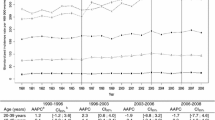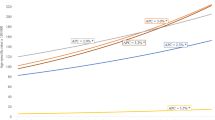Abstract
As a metropolis with rapid social and economic development over the past three decades, Shanghai has a breast cancer incidence that surpasses all other cancer registries in China. In order to estimate the regular changing patterns of female breast cancer in urban Shanghai, population-based incidence data from 1975 to 2004 were studied. In addition, a one-hospital-based in-patient database of 7,443 female breast cancer patients treated surgically between January-1990 and July-2007 were reviewed, retrospectively. We observed that breast cancer incidence increased dramatically over the past 30 years and documented a peak incidence represented by the middle-age group (45–59 years), which emerged in the last 20 years. The incidence peak moved from the 40–44 year group in the previous two decades to the 50–54 year group in the most recent decade. Median age at diagnosis was earlier in Shanghai than in the western countries, although it increased from 47.5-year in 1990 to 50-year in 2007. Considerably higher exposure to reproductive risk factors and relatively fewer hormone-dependent cases were observed. The proportion of asymptomatic cases detected by screening gradually increased, as well as that of early-stage cases (from 78.6% in 1990 to 93.3% in 2007) and carcinoma in situ (14.7% in 2007). Analysis of surgical treatment patterns suggested a trend of less-invasive options. Both age of peak incidence and median age at diagnosis increase with time, which suggests that increased incidence trending along with increasing age, will be observed in the future. Consequently, specific screening protocol should be refined to consider birth cohorts.






Similar content being viewed by others
References
Bernard W, Stewart PK (2003) International Agency for Research on Cancer, World Health Organization. World Cancer Report IARC 2003
Jemal A, Siegel R, Ward E et al (2008) Cancer statistics, 2008. CA Cancer J Clin 58:71–96. doi:10.3322/CA.2007.0010
Parkin DM, Ferlay SWJ, Teppo L, Thomas DB (2002) Cancer incidence in five continents. IARC Sci Publ VIII:1–781
Porter P (2008) “Westernizing” women’s risks? Breast cancer in lower-income countries. N Engl J Med 358:213–216. doi:10.1056/NEJMp0708307
Singletary SE, Allred C, Ashley P et al (2002) Revision of the American Joint Committee on cancer staging system for breast cancer. J Clin Oncol 20:3628–3636. doi:10.1200/JCO.2002.02.026
Shaw de Paredes E, Marsteller LP, Eden BV (1990) Breast cancers in women 35 years of age and younger: mammographic findings. Radiology 177:117–119
Hankey BF, Miller B, Curtis R, Kosary C (1994) Trends in breast cancer in younger women in contrast to older women. J Natl Cancer Inst Monogr 16:7–14
Brown M, Tsodikov A, Bauer KR et al (2008) The role of human epidermal growth factor receptor 2 in the survival of women with estrogen and progesterone receptor-negative, invasive breast cancer: the California cancer Registry, 1999–2004. Cancer 112:737–747. doi:10.1002/cncr.23243
Clarke M, Collins R, Darby S et al (2005) Effects of radiotherapy and of differences in the extent of surgery for early breast cancer on local recurrence and 15-year survival: an overview of the randomised trials. Lancet 366:2087–2106
Pujol P, Hilsenbeck SG, Chamness GC, Elledge RM (1994) Rising levels of estrogen receptor in breast cancer over 2 decades. Cancer 74:1601–1606. doi:10.1002/1097-0142(19940901)74:5<1601::AID-CNCR2820740517>3.0.CO;2-#
Chlebowski RT, Chen Z, Anderson GL et al (2005) Ethnicity and breast cancer: factors influencing differences in incidence and outcome. J Natl Cancer Inst 97:439–448
Newman LA (2004) Locoregional control of breast cancer: surgical technique does matter. Ann Surg Oncol 11:11–13. doi:10.1007/BF02524339
American Cancer Society (2007) Breast cancer facts and figures 2007–2008. American Cancer Society Inc. Atlanta
Son BH, Kwak BS, Kim JK et al (2006) Changing patterns in the clinical characteristics of Korean patients with breast cancer during the last 15 years. Arch Surg 141:155–160. doi:10.1001/archsurg.141.2.155
Yang L, Li LD, Chen YD, Parkin DM (2006) Time trends, estimates and projects for breast cancer incidence and mortality in China. Zhonghua Zhong Liu Za Zhi 28:438–440
Shanghai Municipal Statistics Bureau (2007) Bureau SMS Shanghai statistical yearbook, 2007
Wong IO, Cowling BJ, Schooling CM, Leung GM (2007) Age-period-cohort projections of breast cancer incidence in a rapidly transitioning Chinese population. Int J Cancer 121:1556–1563. doi:10.1002/ijc.22731
Seow A, Hin-Peng L (1994) From colony to city state: changes in health needs in Singapore from 1950 to 1990. J Public Health Med 16:149–158
Du S, Mroz TA, Zhai F, Popkin BM (2004) Rapid income growth adversely affects diet quality in China particularly for the poor!. Soc Sci Med 59:1505–1515. doi:10.1016/j.socscimed.2004.01.021
Howe GR, Hirohata T, Hislop TG et al (1990) Dietary factors and risk of breast cancer: combined analysis of 12 case-control studies. J Natl Cancer Inst 82:561–569. doi:10.1093/jnci/82.7.561
Wang Z, Zhai F, Du S, Popkin B (2008) Dynamic shifts in Chinese eating behaviors. Asia Pac J Clin Nutr 17:123–130
Cui X, Dai Q, Tseng M et al (2007) Dietary patterns and breast cancer risk in the shanghai breast cancer study. Cancer Epidemiol Biomarkers Prev 16:1443–1448. doi:10.1158/1055-9965.EPI-07-0059
Li Y, Schouten EG, Hu X et al (2008) Obesity prevalence and time trend among youngsters in China, 1982–2002. Asia Pac J Clin Nutr 17:131–137
Bell AC, Ge K, Popkin BM (2002) The road to obesity or the path to prevention: motorized transportation and obesity in China. Obes Res 10:277–283. doi:10.1038/oby.2002.38
Tabar L, Yen MF, Vitak B et al (2003) Mammography service screening and mortality in breast cancer patients: 20-year follow-up before and after introduction of screening. Lancet 361:1405–1410. doi:10.1016/S0140-6736(03)13143-1
Humphrey LL, Helfand M, Chan BK, Woolf SH (2002) Breast cancer screening: a summary of the evidence for the US Preventive Services Task Force. Ann Intern Med 137:347–360
Duffy SW, Tabar L, Chen HH et al (2002) The impact of organized mammography service screening on breast carcinoma mortality in seven Swedish counties. Cancer 95:458–469. doi:10.1002/cncr.10765
Thomas DB, Gao DL, Ray RM et al (2002) Randomized trial of breast self-examination in Shanghai: final results. J Natl Cancer Inst 94:1445–1457
Yu KD, Di GH, Wu J et al (2007) Development and trends of surgical modalities for breast cancer in China: a review of 16-year data. Ann Surg Oncol 14:2502–2509. doi:10.1245/s10434-007-9436-2
Acknowledgments
The authors thank the studied women for their willingness to cooperate with our study. This research was supported in part by the grants from the National Basic Research Program of China (2006CB910501), National Natural Science Foundation of China (30371580, 30572109); Shanghai Science and Technology Committee (03J14019, 06DJ14004, 06DZ19504).
Author information
Authors and Affiliations
Corresponding author
Additional information
Lei Fan, Ying Zheng, and Ke-Da Yu co-authors contributed equally to this work.
Rights and permissions
About this article
Cite this article
Fan, L., Zheng, Y., Yu, KD. et al. Breast cancer in a transitional society over 18 years: trends and present status in Shanghai, China. Breast Cancer Res Treat 117, 409–416 (2009). https://doi.org/10.1007/s10549-008-0303-z
Received:
Accepted:
Published:
Issue Date:
DOI: https://doi.org/10.1007/s10549-008-0303-z




